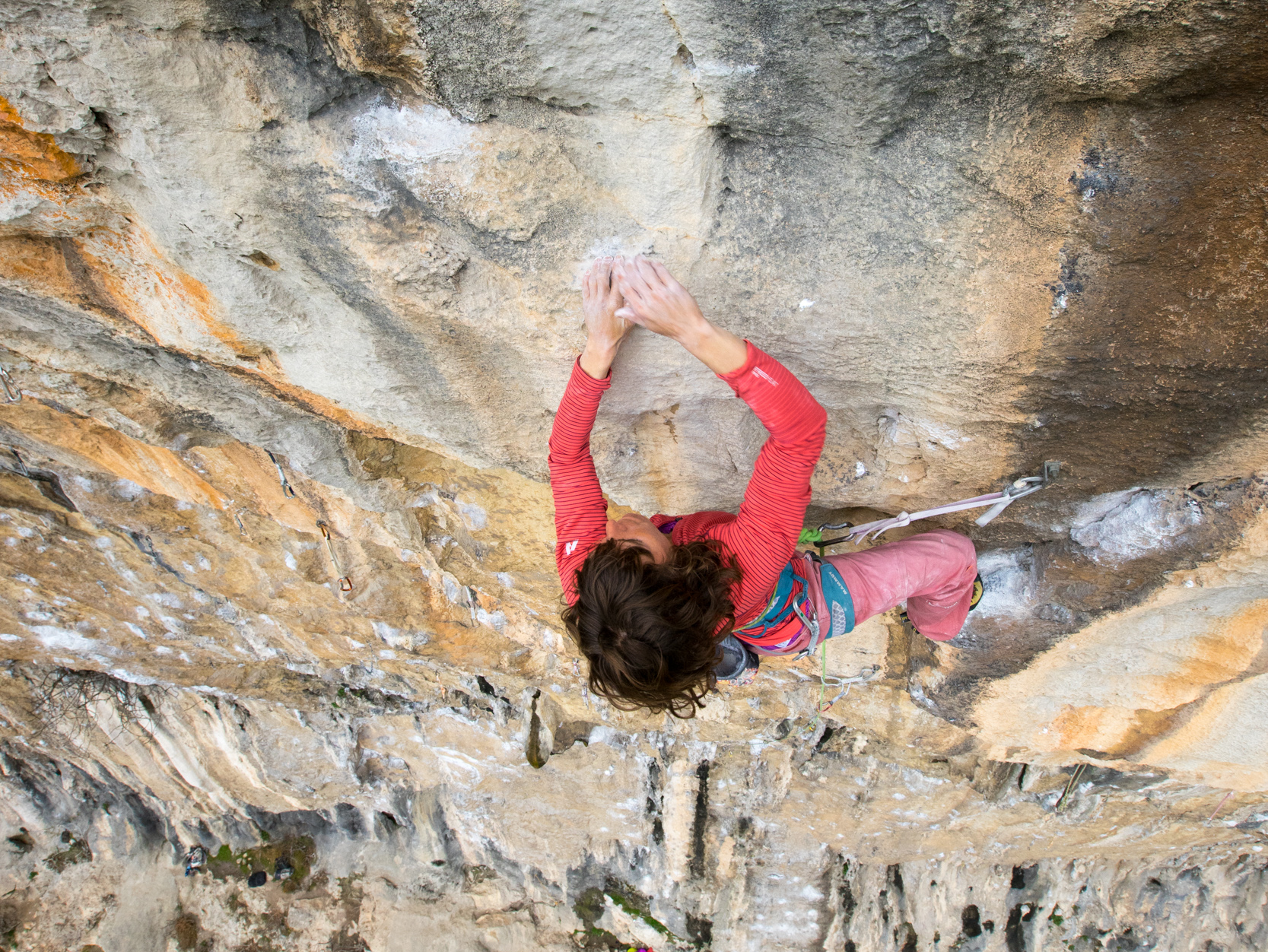
Interview with Katie Lambert about climbing in Istria
Katie Lambert climbing Ptičja perspektiva (8a+) in Mišja peč @ photo by Benjamin Ditto www.bendittophoto.com
Katie’s husband Benjamin Ditto, a professional photographer, who took the fabulous photos of her climbing in Mišja peč also redpointed Kaj ti je deklica (8b+) and onsighted Zadnja skušnjava (8a), just to mention a few of them.
Katie Lambert is a Yosemite based professional climbing instructor with more than 20 years of climbing experience from the big walls, traditional climbing to sport climbing who has travelled in search for the perfect limestone a lot through the Europe’s best climbing areas like Spanish Rodellar, Oliana, Chulilla or Siurana, French Ceuse, Gorge du Tarn, Verdon, Turkish Geyik Bayiri just to name a few of them. An accomplished rock climber with credits to her name including free climbing the West Face of Leaning Tower (8a) in a day in Yosemite Valley, free climbing the Regular Northwest Face of Half Dome (7b) in a day in Yosemite, redpointing the Tuolumne Meadows slabby testpiece Peace (8b), the first female ascent of Kepper of the Flame (5.13) in Yosemite, the first female ascent of Broken Arrow (5th ascent overall of this traditional 8b in Toulomne Meadows), a climber with a redpoint of 8b+ under her belt (China Crisis in Oliana) and an onsight of 8a (Entre dos caminos in Chulilla).
We have prepared a short reflection interview about Katie’s visit to Osp and Mišja peč in March this year when after her injury she redpointed in a handful of tries classics like Ptičja perspektiva (8a+), Urbanova (8a), Uživancija (8a),…
– First of all, where and when did you hear about climbing in Osp or Mišja peč?
I must have heard about the climbing in Slovenia close to 15 years ago from some American climbing media. I recall there being a lot od buzz about this place being really stout and stacked with routes. It had always stuck out in my mind as this old-school place of real quality that I must check out but the timing was never right until this year.
– For how long were you here for and where did you stay? Did you enjoy it?
We stayed for 5 weeks at the Hostel Ociski Raj with Jana. We had such a lovely visit that it exceeded any and all expectations we had. The hostel is in a great location and was really affordable and Jana is just one of those people that you just really enjoy being around.
– You told me that usually you stay longer to get to know the area where you travelled to better, but still, how did you like climbing and life over here? Can you describe us your experience in Slovenia’s best climbing area?
It’s true we like to spend about 6 to 8 weeks in an area. That way we can really get to know the place more intimately. I love travelling for climbing because it brings us to so many rural and unusual places and it’s always a great experience to meet the locals and get to know the whole vibe. Slovenia blew my mind in many ways. It’s a small country but there seems to be a lot of pride in the people. The Slovenians are no slouches when it comes to being badass athletes so it was really cool to see where it is you guys play and practice. The land is really beautiful and the people seem to really take care and appreciate it. The food was great, too. I really enjoyed getting to taste some of the local and wild agriculture like the asparagus and truffles. Every household in the village also had really epic gardens and the place was just thriving with life. All of the people we met were very open and straightforward and seemed really good with one-another. I have seen this a lot traveling throughout Europe but there was something a little different this time around; things felt really solid from relationships, to the climbing. I was injured when we first arrived to Mišja peč with a badly sprained ankle and was unable to climb for the first 2 weeks we were there. I was largely disappointed by this because I had planned the trip with the idea of climbing some really hard routes and my injury was forcing me to take a different approach. Luckily, though, I saw a really good fizio named Alan Lilic based in Hrpelje who really helped me out and I was able to do some fun climbing the last couple of weeks we were there.
– How did you like climbing in the Osp valley?
I loved the climbing in the Osp Valley. It was both technical and powerful and required some faith to trust the feet. I found it to be an old-school style and true to the grades, which I really appreciated.
– And the atmosphere at the crag?
The atmosphere at the crag was usually pretty relaxed. There were a few weekends close to Easter that it got really busy and there were many large groups climbing but it was still possible to climb whatever you wanted to. Both Osp and Mišja peč are beautiful crags and the birds were really nice to watch and climb around. We topped out Magic Mushroom one day and were greeted by a Lataste’s Viper, which was really special. The vibe amongst the people at the crags was also really chill and friendly. Everyone just seemed so psyched to be out.
– What do you think about next generation of climbers regarding their attitude and approaches in rocks?
In our travels we have seen a lot of really strong young climbers but this trip took things to a whole new realm. The last week we were there a youth team from the Ukraine arrived and they were so next level. There were about 10 of them and they were all climbing really well – onsight warming up on 8a, doing 8c in a handful of tries and the 9as. I enjoyed watching them climb because they taught me something that I had forgotten some time ago – they reiterated approaching climbing with a “childs” mind – free of any preconceptions, worries, stresses. They looked truly free in their climbing and it inspired me to channel my inner child’s mind when I climb. But, something I think that is largely absent from the next generation is the appreciation and stewardship of the land. I think its taken for granted and looked over. Perhaps their focus is too uch on climbing hard grades and not enough is directed at the beauty and specialness of the place or how to take care of the area.
– What about the grades? Did you find them soft or hard?
I found the grades to be quite true, similar to climbing in France. Definitely not soft, you’re going to have to work for it.
– Some special memories from Slovenia?
The day we climbed Magic Mushroom was also the day our friend Luka Krajnc freed an old aid line (the route Stara) on the right side of the big wall at Osp. It was really exciting to hear him from where we were and to see him as we descended the rap route. We also talked with one of the local villagers of Osp one day in his olive grove – our common language was Spanish, which was funny, but it was really nice to converse with someone who had been there for so long and a get a little perspective from a non-climber on what it’s like to live there. I am always so enamored with all of the places we travel too, especially because of the steep limestone. We just don’t have much of that kind of climbing in the States so to me being able to live in a little village, grow food and climb on such rock just seems like the best life. We made some nice new friends and I always enjoy that about visiting a new crag. We did some touristy stuff while I was injured and really took advantage of the great location of Slovenia to Italy and Croatia.
– What would you recommend to the first time visitors of Istria? What should they take care of and what they should not miss at all?
I think people should, aside from the climbing, check out Piran, Trieste, Bled, and Croatia. All of those places are close by and offer something special. Immersing oneself in the food culture is never a bad option either and getting to know the locals is a really great way to enjoy a new place. We really enjoyed eating sometimes at this place in Kozina called Tonca – I think I may have had the best hamburger ever there. The mountains aren’t far away and driving up to Bled for the day was really lovely. If you go there one must have the “kremšnita”. We didn’t get to see any of the caves, but I hear they are pretty amazing.
– What are in your opinion the ups & downs of climbing in Istria?
I have come to understand that there is no set organization or group that takes care of the crag(s). So, all of the rebolting and maintaining of anchors, etc is just up to the people. This can be good and bad. It allows for a lot of freedom as far as establishing new routes but it also has a drawback because it puts a burden on individuals to take care of replacing bolts and anchors. This can be financially difficult and result in routes that need to be rebolted and anchors that need replacing but are just kind of left alone because there is no one to do it. I think there is room for some kind of fundraising or something like that for the crags at Osp and Mišja peč.
Another thing that I think would be helpful and that goes along the same lines is crag stewardship. There was a fair bit of small trash and a lot of human waste and toilet paper in the trees. And I totally understand, when you gotta go you gotta go. But the toilet paper should not be left there, it should be taken out. Whoever uses it should know to take it back with them. This is something I have seen a fair bit throughout European climbing areas. In the states we have a Leave No Trace ethic that emphasis the idea of packing out what you brought in. Taking your poo home with you in your bag probably isn’t going to happen but taking your toilet paper back with you is definitely doable. The same goes for food wrappers and such. The area is just so beautiful though that the scenery and quality of climbing make up for any unsightliness from humans.
– Where is the difference in comparison Osp/Mišja peč to the famous crags of Spain or France for instance?
I’ve been surprised in our travels to famous crags with how much “chossy” rock there actually is at these places. Osp/Mišja peč do have some sections of more broken and lesser quality rock but on the whole the rock is really impeccable. I found the style to be really interesting and engaging. It’s not just about brute force but also requires good technique and endurance. At certain crags it can usually just be one or the other, it is rare that you find a crag with loads of hard routes that require all of the above. In that way it reminded me of climbing that one might find in France. I also found the grades to be comparable with french standards.
– And what about if you compare Osp/Mišja peč to the U.S. crags like Red river gorge, Yosemite,…?
The Red is one of those places that in general requires mostly endurance. There are some routes that require more power but it’s rare that you would find something there that requires all of the things. The climbing in the Red is also more approachable for more people I think whereas the climbing at Osp/Misja Pec requires a little bit more from you if you really want to climb hard.
Yosemite is in a league of its own in a way. It’s hard, it’s insecure and in general is a total slab. You’re lucky if you find something steep. It also requires really good technique, power and endurance and nothing there is soft. And it’s loaded with old bolts and sketchy anchors. It’s totally adventurous and should be a destination of any climber.
– Would you like to return here?
I would absolutely return to Slovenia. There are some harder routes that climbed on my last week there that I would love to go back for as well as try some others that piqued my interest. Plus, I’d like to see our friends again. It’s a really special part of the world and I feel fortunate that we took the time to go.

